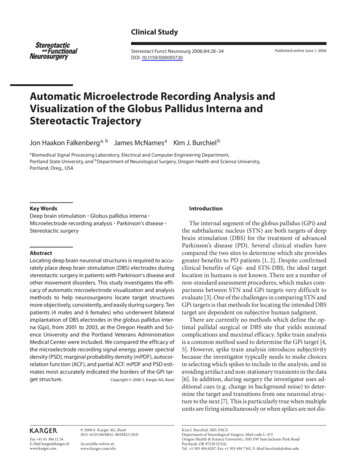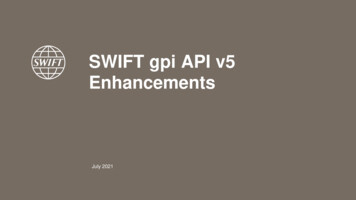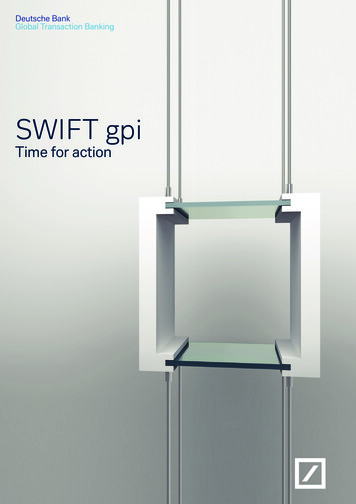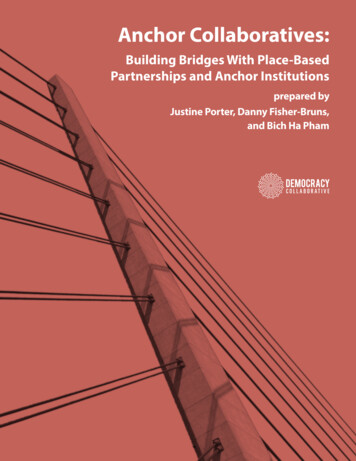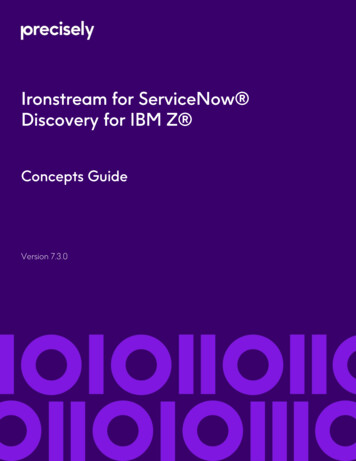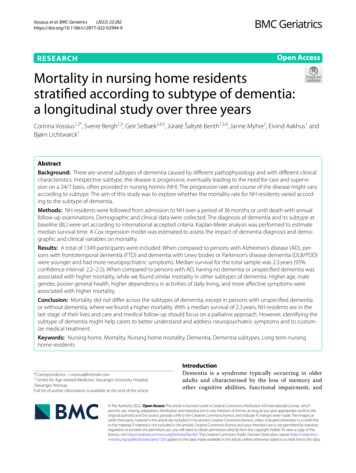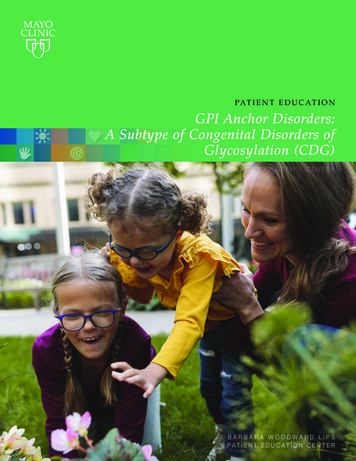
Transcription
PAT I E N T E D U C AT I O NGPI Anchor Disorders:A Subtype of Congenital Disorders ofGlycosylation (CDG)M AY O C L I N I C C H I L D R E N ’ S C E N T E RBARBARA WOODWARD LIPSPATIENT EDUCATION CENTER
Mayo Clinic Children’s CenterFor more than 100 years, teams of physicians have cared for children at Mayo Clinic.T. DENNY SANFORD PEDIATRIC CENTERMAYO EUGENIO LITTA CHILDREN’S HOSPITALPediatric Sub-Specialties in the following areas:Allergy and ImmunologyAnesthesiologyCardiologyCardiovascular SurgeryChild and FamilyAdvocacy ProgramCommunity Pediatrics andAdolescent MedicineCritical CareDermatologyDevelopmental andBehavioral PediatricsEmergency MedicineEndocrinology and MetabolismGastroenterology and HepatologyGeneral Pediatric andAdolescent MedicineGynecology, AdolescentHematology and OncologyInfectious DiseasesMedical GeneticsNeonatal gyOral and Maxillofacial SurgeryOrthopedic SurgeryOtorhinolaryngology (ENT)Physical Medicine and RehabilitationPlastic and Reconstructive SurgeryPsychiatry and PsychologyPulmonologyRadiation OncologyRadiologyRegional (Health System)PediatricsResearchRheumatologySleep Medicine CenterSpeech PathologySurgeryUrologyDana Child Developmental andLearning Disorders ProgramDermatology Genetics ClinicDiabetes ClinicEating Disorders ClinicEosinophilic Esophagitis ClinicEpilepsy ClinicErythromelalgia ClinicFacial Paralysis andReanimation ClinicFeeding ProgramFertility PreservationFetal Surgery ProgramFriedreich’s Ataxia ClinicFunctional MovementDisorder ProgramHeart Failure ClinicHemophilia/Coagulopathy ClinicHyperlipidemia ProgramImmunodeficiency Disorders ClinicInflammatory Bowel Disease ClinicLearning DisordersAssessment ClinicLong QT Syndrome ClinicMarfan Syndrome ClinicMetabolic Bone ClinicMood Disorders ClinicNeonatal Follow-Up ClinicNeuromuscular ClinicPain ClinicPain Rehabilitation CenterPediatric Diagnostic Referral ClinicPediatric Level 1 Trauma CenterPlagiocephaly ProgramPulmonary Hypertension ProgramRenal Stone ClinicSpina Bifida ClinicSpinal Deformities ClinicSports Medicine CenterThyroid Nodule/Cancer ClinicTransgender ClinicTransitions ProgramTransplant CenterTravel ClinicVascular MalformationsVelo-PharyngealInsufficiency ClinicVoiding ClinicWeight Management ClinicPediatric Specialty Clinics:Adrenoleukodystrophy ClinicAerodigestive ClinicAnxiety Disorders Clinic andIntensive Therapy ProgramArrhythmia and DevicePlacement ClinicAsthma CenterAttention Deficit HyperactivityDisorders (ADHD) ClinicBariatric Surgery ClinicBrain Injury ProgramBrain Tumor ClinicCerebral Palsy ClinicChemotherapy/RadiationLong-Term Effects ClinicChild and Adolescent IntensiveMood Program (CAIMP)Childhood Sarcoma ClinicComPASS (Palliative Care andIntegrative Medicine)Congenital Heart ClinicConstraint Induced MovementTherapy ProgramCraniofacial ClinicCystic Fibrosis Center
Learn All You Can About Your Child’sConditionGPI anchor disorders are a subtype of a rare genetic condition called congenitaldisorders of glycosylation, also called CDG. Finding out your child has a rare geneticcondition like GPI anchor disorders can be hard. You probably have many questionsand you may feel overwhelmed. Your child’s health care team is here to help.Read this resource to learn about the condition and medical terms you are likely to hear.Read about the causes, symptoms and how the condition is diagnosed and treated. Alsolearn about the health care providers who may be a part of your child’s care over time.Talk to your child’s health care team at any time if you have questions. Learning moreabout the condition can help you care for your child and make plans for the future.The quotes you see throughout this resource were provided bythe mother of two daughters who have GPI anchor disorders. Shehas shared her wise words and special story to help you on yourjourney as the parent of a child with this condition.1
Understanding CDGTo understand GPI anchor disorders, it can help to first learn about CDG.Congenital disorders of glycosylation (CDG) are a large group of rare, inheriteddisorders. These disorders affect a complex process in the body called glycosylation.Most children who have CDG have neurological and developmental problems, growthdelays and problems with organs not working like they should.Congenital means that CDG is a condition that happens at or before birth. Notice thatdisorders is plural. This is because CDG is a group of disorders. There are many subtypes.The subtype a child has depends on which body system is affected.GPI anchor disorders is one of those subtypes. Within GPI anchor disorders, there arealso many more subtypes.About glycosylationGlycans are sometimes called sugar trees, antennas or sugar chains by health careproviders. They are built from sugar building blocks.When some people hear sugar, they think of blood sugar, blood glucose or diabetes.This is not the case with glycans, which are not used for burning calories.Glycosylation is the process of creating, changing and attaching these sugar buildingblocks to proteins and lipids. When the sugar building blocks attach to proteins, they are called glycoproteins. When the sugar building blocks attach to lipids, they are called glycolipids.See Figure 1 for how glycosylation works in someone who does not have CDG.“Rely on your health care team for information. Don’t put toomuch effort into medical research online because much of what’sout there is outdated and doesn’t capture the capabilities of ourchildren. Each child will write his or her own story.”2
Every single system in the body needs the process of glycosylation to work right so thebody can function as it should. This is why people who have CDG have many healthproblems. Many body systems are affected by glycosylation not working correctly.“This is a difficult diagnosis and the uncertainty can feelunbearable, but there is a community of families who canprovide unconditional love and encouragement.”3
Understanding GPI Anchor DisordersA glycolipid is made from sugar building blocks and fat. GPI (glycosylphosphatidylinositol)is a glycolipid anchor. The GPI anchor is responsible for attaching some proteins to theoutside of the cell surface membrane.When the GPI anchor does not form as it should, proteins are not able to stay anchoredto the cell membrane. The proteins attached to the GPI anchor have several importantroles. See Figure 2.Cell membrane1. Sugars enter the cellEndoplasmic reticulum2. Glycophospholipidis built and attachedto proteinGolgi3. Fatty acid andglycophospholipidremodeling occursFigure 2. Glycosylation in a cell with healthy GPI anchor synthesisGPI anchor disorders is one of the rarest subtypes of CDG. All subtypes of GPI anchordisorders are named for a specific step in the genetic pathway. They are named usingletters. For example, some subtypes are PIGA-CDG, PIGB-CDG and PIGC-CDG.4
Symptoms of GPI Anchor DisordersSymptoms can vary between each child with GPI anchor disorders. Symptoms areeven different among family members with the same type. Symptoms can range frommild to severe.GPI anchor disorders can affect every system in the body. Which symptoms andcomplications your child has depends on which systems are affected. Because it isso rare, it is hard for health care providers to have a complete list of symptoms. Noteveryone with the condition has every symptom.Some children have serious medical conditions caused by GPI anchor disorders that canbe life-threatening. Your child may often be in the hospital, sometimes for long stays.Neurological problems Developmental delays, such as talking and walking later than others Cognitive impairment Seizures Low muscle tone Poor balance and coordination problems Slurred speech or no speech Crossed eyes Rapid eye movement Cortical visual impairment or delayed visual maturation Hearing lossGrowth and feeding problems Feeding difficulties leading to slow weight gain Poor swallowing abilityProblems related to your child’s organs not working as they should Gastrointestinal symptoms, such as throwing up, diarrhea and constipation Congenital heart defects Frequent respiratory infections Stiffening of the heart muscles Calcification of the kidneys or kidney cysts Liver problems5
Endocrine problems Decreased thyroid hormone activity Low blood glucose levelsMuscle, bone, teeth and joint problems Teeth problems and a high-arched palate Joint problems Fingers or toes that do not form as they should High levels of a bone enzyme called alkaline phosphataseHematologic problems Increased risk of forming blood clotsOther problems Severe or long-lasting infections Dry skin6
Your Child’s Health Care TeamYour child may need care from many medical specialists. Over time, your child mayhave many appointments with different members of the care team. After your child hasbeen seen the first time, each provider usually recommends when the next follow-upvisit will be.Your child’s health care team may include the following: A medical genetics specialist Genetic counselors A primary care pediatrician Nurse practitioners and special nurses Neurologists Physical therapists (PT) Occupational therapists (OT) Speech language pathologists (SLP) Registered dietitians Gastroenterologists Endocrinologists Cardiologists Vision therapists Ophthalmologists Orthotist7
Depending on your child’s unique health concerns, the team may alsoinclude the following: Hepatologists Nephrologists Hematologists Audiologists Otolaryngologists Financial representatives Social workersMembers of your child’s health care team work together to provide care and support.They help your child develop each ability to the highest level that can be reached. Youand your child are the most important members of this team.“Be an advocate for your child. We as parents know and understandmore about our kids than most doctors. CDG kids don’t act medicallylike other kids.”8
Cause of GPI Anchor DisordersTo understand the cause of GPI anchor disorders, it helps to understand genesand heredity.About genesMost people have 46 chromosomes in all their cells. Each chromosome is made up of along chain of chemicals called deoxyribonucleic acid (DNA).A gene is a section of one of these DNA chains. See Figure 3.Everyone is unique because of individual genes. Genes are like an instruction book thattells your cells how to work. For example, genes determine everything from your eyecolor to your blood type to your height.GPI anchor disorders are caused by mistakes or changes in genes. Health care providersused to call these mutations. They are now called pathogenic genetic variants.9
Pathogenic genetic variants are like words in a sentence that are spelled wrong or arein the wrong order. The sentence cannot be read correctly when this happens. Inheritedgenetic variants pass from a parent to a child. At birth, they are in every cell of a child’sbody. Genetic variants can be inherited from either the mother or the father.Pathogenic genetic variants can keep cells from doing their work correctly, whichcan lead to genetic diseases like CDG. Genes determine how well the process ofglycosylation works in your body. There are over 400 genes in the human genome thathave a role in the process of glycosylation.About paroxysmal nocturnal hemoglobinuria (PNH)If you search on the internet for information about the gene variant that causesGPI anchor disorders, you may get information about a condition calledparoxysmal nocturnal hemoglobinuria (PNH). This is because PNH has beenlinked to the PIGA genes and different types of genetic variants in the PIGAgene can also cause the GPI anchor disease called PIGA-CDG.PNH is not a CDG. PNH is a blood disease in which a person’s own bodyattacks and destroys red blood cells. This is a very different condition from GPIanchor disorders.10
Diagnosing GPI Anchor DisordersGPI anchor disorders are usually diagnosed when your child is a baby. To make adiagnosis, your child’s health care provider does a thorough physical exam and talksto you about your and your family’s medical history.Children with GPI anchor disorders are often mistakenly diagnosed with other conditions.This is because their symptoms are similar to symptoms of other conditions. Some aremistakenly diagnosed with cerebral palsy or other neurological or genetic disorders. Animportant part of diagnosis is ruling out other conditions. At this time, genetic testing is theonly way to diagnose GPI anchor disorders.Additional tests your health care team may requestDepending on symptoms or problems your child has, you may be referred to specialistsfor tests of other conditions that are often associated with GPI anchor disorders. Some ofthese tests are done to learn more to help manage the symptoms of the condition.Your child may have the following tests: Imaging exams, such as abdominal ultrasounds, X-rays and MRIs. Electrocardiogram (ECG) to check heart function Electroencephalogram (EEG) to determine seizure activity Blood test to measure vitamin B6 metabolites Blood tests for elevated liver enzymes such as alkaline phosphatase, ALT and AST Other special blood tests, such as measuring the GPI anchored proteins on thesurface of blood cells“The diagnosis can be overwhelming and take a long time toprocess. I feel like it took a year for us to work through it.”11
Overview of Treatment and SupportiveServicesAlthough there is currently no cure for GPI anchor disorders, there are many treatmentsand therapies available to help your child. The goal of these treatments is to treat thesymptoms and the problems caused by the condition. This type of treatment is calledsupportive therapy.Supportive therapy may include:Physical therapy — A physical therapist (PT) can work with your child to developexercises that may help your child’s strength, flexibility, balance, motor developmentand mobility.Speech therapy — Speech-language pathologists (SLP) can help improve your child’sability to speak clearly or to communicate. Speech therapy may help your childcommunicate using sign language, picture systems or talking devices.Occupational therapy — Occupational therapists (OT) can help develop fine motorskills that support self-feeding, writing, balance and coordination.Other treatment may include: Seizure management. Nutrition including tube feeding if needed. Heart medication. Hormone supplements to treat growth problems. Antibiotics to treat or prevent infection. Special diet, such as a ketogenic diet to control seizures. Supplements for vitamin deficiencies, such as vitamin B6.12
Supportive services may include:Durable medical equipment companies (DME) — DME companies help supplywheelchairs, hospital beds, walkers, ventilators, oxygen, standers, special adaptivebikes and other home monitoring equipment. DME companies require prescriptionsfrom your health care team to provide this equipment.Home infusion companies — Infusion companies can supply tube feedingsupplies necessary to feed your child. Sometimes DME companies also supplytube feeding supplies.Orthotic services — An orthotist is a health care provider who fits children for specialbraces recommended by physical therapists to support mobility.Other supportive services — States can provide financial and social service assistanceto help care for a child with GPI anchor disorders. Check with local government andcounty agencies to see what services may be available to your family.Also, social media can be a useful resource to connect with other families who havechildren with GPI anchor disorders.“Thesekids havejoy and aperspectivewe canall learnfrom.”13
A Message From a ParentI am the mom of three children. Two of them are little girls who have GPI anchor disorders.With my oldest daughter, I began to suspect something was wrong when she was verylittle. She seemed behind in her development. My husband and I did not have genetictesting done at that time.We had a second child, a little boy, and he developed normally. Then when I gotpregnant again, I worried whether this child would be OK. After she was born, Inoticed something wrong with her vision. Her eyes didn’t seem to track well. Ourdoctor ordered neurological and genetic testing. This is when we got a clear diagnosison both our daughters: GPI anchor disorders. I had never heard of this condition!I tried to learn more about the condition by searching on the internet. I joined somesocial media groups and learned about specialists who treat this condition. Thespecialist connected us with other doctors around the world so I could learn more.My oldest daughter communicated using sign language until she was 4 years old. Thenshe started talking verbally. She has large motor problems and uses a walker. She can’tstand up without help, but she can crawl and pull up. My youngest daughter is verballylimited. She uses sign language too.Yes, my girls have GPI anchor disorders — but there is so much more to them! My oldestis spunky, determined, shy in front of others and loved by all at her school. I call her “mylittle mommy” because she loves housework and always wants to help. She’s so sweet.My youngest has this beautiful brown curly hair. She is a spitfire! She’s got such sass.My advice to other parents of children with GPI anchor disorders and any subtypeof CDG is to appreciate all that goes into loving a child with special needs. Althoughtimes will be tough, there is so much joy in everyday victories.Once the shock of the diagnosis wears off, you will quickly realize you have been givena gift to appreciate deeply that others may never understand. I distinctly rememberhow grateful I was when my son, who doesn’t have CDG, was able to stand withoutassistance. I was overjoyed! It was a simple milestone, but one that made me realize justhow much other parents take for granted what should be celebrated.Build a support network by joining social media groups for the condition. It can helpyou connect with others around the world. Build a stronger local support network asthere will be days when you need hands to help. Use services offered to you locally.Contact the county’s health department to find out about support services that areavailable to your child and family. Connect with your school district to see what isavailable to your child even before he or she is old enough to attend school.My hope for my daughters is they continue to live their lives being true to themselvesand profoundly impacting others around them.14
Terms You May Hear or Read About GPIAnchor DisordersMedical conditions can be complicated and genetic conditions are especially complicated.Here is a list of terms you are likely to read or hear. Understanding these terms canhelp you have good conversations with your child’s health care provider.Ataxia — Poor balance and coordination.Autosomal — Humans have 23 pairs of chromosomes. One pair determines which sexa person is. The other 22 are called autosomes.Carrier — A person who has the gene for a condition or trait that can be passed on tohis or her children.Chromosomes — Any of the DNA-containing structures located in the nucleus of cellsthat contain all or most of the genes in an organism.Congenital — Term used to describe a condition someone has from birth.Dysphagia — Poor swallowing ability.Enzymes — Complex proteins produced by cells that cause biochemical reactions.Enzyme assay — A test that is done to measure a protein’s activity to determine howefficient the protein is in biochemical reactions.Esotropia — Crossed eyes.Failure to thrive — Term used to describe when a child does not gain weight and growas he or she should.Gene — A coding sequence in the DNA. A specific mistake in a gene causes aspecific disease.Gene variant — Changes in the DNA code in a specific gene.Genetic code — A DNA code written using four letters: A, T, C, and GGenetic — Relating to or caused by genes.Glycoproteins — Sugar blocks attached to lipids.Hypothyroidism — Decreased thyroid hormone.Hypotonia — Low muscle tone.15
Ichthyosis — Dry skin.Metabolism — The process by which your body converts what you eat and drinkinto energy.Mutations — This term was previously used by providers to describe a mistake ingenetic code. The new term used is pathogenic genetic variant.Nystagmus — Rapid eye movement.Oligosaccharides — Sugar blocks assembled in a chain.Pathogenic genetic variant — Mistake in the DNA code in a specific gene. This usedto be called a mutation.Prognosis — The anticipated or expected plan for healing or recovery.Restrictive cardiomyopathy — Stiffening of the heart muscle.Thrombosis — Increased risk of forming blood clots.”The path life has taken is nowhere near what I expected, butthe gratitude and appreciation I’ve been given is by far a gift Iwouldn’t trade for the world. My kids continually show me howto appreciate the small things in life.”16
Notes17
Notes18
Notes19
Notes20
BARBARA WOODWARD LIPS PATIENT EDUCATION CENTERMrs. Lips, a resident of San Antonio, Texas, was a loyal Mayo Clinic patient of more than 40 years and a self-made business leader who significantly expandedher family’s activities in oil, gas and ranching. Upon her death in 1995, Mrs. Lips paid the ultimate compliment by leaving her entire estate to Mayo Clinic. Bynaming the Barbara Woodward Lips Patient Education Center, Mayo honors her generosity, her love of learning, her belief in patient empowerment and herdedication to high-quality care.This material is for your education and information only. This content does not replace medical advice, diagnosis or treatment. New medicalresearch may change this information. If you have questions about a medical condition, always talk with your health care provider.MC8536
Mayo Clinic Children's Center For more than 100 years, teams of physicians have cared for children at Mayo Clinic. . Neuromuscular Clinic Pain Clinic Pain Rehabilitation Center Pediatric Diagnostic Referral Clinic Pediatric Level 1 Trauma Center Plagiocephaly Program Pulmonary Hypertension Program
